ZHCSDL4 April 2015 TPS61046
PRODUCTION DATA.
- 1 特性
- 2 应用
- 3 说明
- 4 简化电路原理图
- 5 修订历史记录
- 6 Pin Configuration and Functions
- 7 Specifications
- 8 Detailed Description
- 9 Application and Implementation
- 10Power Supply Recommendations
- 11Layout
- 12器件和文档支持
- 13机械封装和可订购信息
7 Specifications
7.1 Absolute Maximum Ratings
over operating free-air temperature range (unless otherwise noted) (1)| MIN | MAX | UNIT | ||
|---|---|---|---|---|
| Voltage range at terminals (2) | VIN, EN, FB | – 0.3 | 6 | V |
| SW, VOUT | –0.3 | 32 | V | |
| Operating junction temperature range, TJ | –40 | 150 | °C | |
| Storage temperature range, Tstg | –65 | 150 | °C |
(1) Stresses beyond those listed under Absolute Maximum Ratings may cause permanent damage to the device. These are stress ratings only, which do not imply functional operation of the device at these or any other conditions beyond those indicated under Recommended Operating Conditions. Exposure to absolute-maximum-rated conditions for extended periods may affect device reliability.
(2) All voltage values are with respect to network ground terminal.
7.2 ESD Ratings
| VALUE | UNIT | |||
|---|---|---|---|---|
| V(ESD)(1) | Electrostatic discharge | Human body model (HBM), per ANSI/ESDA/JEDEC JS-001, all pins(2) | ±2000 | V |
| Charged device model (CDM), per JEDEC specification JESD22-C101, all pins(3) | ±500 | V | ||
(1) Electrostatic discharge (ESD) to measure device sensitivity and immunity to damage caused by assembly line electrostatic discharges in to the device.
(2) JEDEC document JEP155 states that 500-V HBM allows safe manufacturing with a standard ESD control process.
(3) JEDEC document JEP157 states that 250-V CDM allows safe manufacturing with a standard ESD control process.
7.3 Recommended Operating Conditions
over operating free-air temperature range (unless otherwise noted)| MIN | TYP | MAX | UNIT | ||
|---|---|---|---|---|---|
| VIN | Input voltage range | 1.8 | 5.5 | V | |
| VOUT | Output voltage range | 4.5 | 28 | V | |
| L | Effective inductance range | 1.0×0.7 | 10 | 22×1.3 | µH |
| CIN | Effective input capacitance range | 0.22 | 1.0 | µF | |
| COUT | Effective output capacitance range | 0.22 | 1.0 | 10 | µF |
| TJ | Operating junction temperature | –40 | 125 | °C |
7.4 Thermal Information
| THERMAL METRIC(1) | TPS61046 | UNIT | |
|---|---|---|---|
| YFF (WCSP) | |||
| 6 BALLS | |||
| RθJA | Junction-to-ambient thermal resistance | 135.4 | °C/W |
| RθJC(top) | Junction-to-case (top) thermal resistance | 1.6 | |
| RθJB | Junction-to-board thermal resistance | 22.3 | |
| ψJT | Junction-to-top characterization parameter | 5.6 | |
| ψJB | Junction-to-board characterization parameter | 22.3 | |
| RθJC(bot) | Junction-to-case (bottom) thermal resistance | n/a | |
(1) For more information about traditional and new thermal metrics, see the IC Package Thermal Metrics application report, SPRA953.
7.5 Electrical Characteristics
TJ = –40°C to 125°C, VIN = 3.6 V and VOUT = 12 V. Typical values are at TJ = 25°C, unless otherwise noted.| PARAMETER | TEST CONDITIONS | MIN | TYP | MAX | UNIT | |
|---|---|---|---|---|---|---|
| POWER SUPPLY | ||||||
| VIN | Input voltage range | 1.8 | 5.5 | V | ||
| VIN_UVLO | Under voltage lockout threshold | VIN rising | 1.75 | 1.8 | V | |
| VIN falling | 1.55 | 1.6 | ||||
| VIN_HYS | VIN UVLO hysteresis | 200 | mV | |||
| IQ_VIN | Quiescent current into VIN pin | IC enabled, no load, no switching, VIN = 1.8 V to 5.5 V, VOUT = 12 V | 110 | 200 | µA | |
| ISD | Shutdown current into VIN pin | IC disabled, VIN = 1.8 V to 5.5 V, TJ up to 85°C | 0.1 | 0.8 | µA | |
| IC disabled, VIN = 1.8 V to 5.5 V, TJ up to 60°C | 0.5 | µA | ||||
| OUTPUT | ||||||
| VOUT | Output voltage range | 4.5 | 28 | V | ||
| VOUT_12V | 12-V output voltage accuracy | FB pin connected to VIN pin, TJ=0°C to 125°C | 11.7 | 12 | 12.3 | V |
| VREF | Feedback voltage | PWM mode, TJ=0°C to 125°C | 0.779 | 0.795 | 0.811 | V |
| PFM mode, TJ=0°C to 125°C | 0.803 | V | ||||
| VOVP | Output overvoltage protection threshold | 28 | 29.2 | 30.4 | V | |
| VOVP_HYS | Over voltage protection hysteresis | 0.8 | V | |||
| IFB_LKG | Leakage current into FB pin | 200 | nA | |||
| ISW_LKG | Leakage current into SW pin | IC disabled, TJ up to 85°C | 500 | nA | ||
| POWER SWITCH | ||||||
| RDS(on) | Isolation MOSFET on resistance | VOUT = 12 V | 850 | mΩ | ||
| Low-side MOSFET on resistance | VOUT = 12 V | 450 | ||||
| fSW | Switching frequency | VIN = 3.6 V, VOUT = 12 V, PWM mode | 850 | 1050 | 1250 | kHz |
| tON_min | Minimal switch on time | 150 | 250 | ns | ||
| ILIM_SW | Peak switch current limit | VIN = 3.6 V, VOUT = 12 V | 600 | 900 | 1200 | mA |
| ILIM_CHG | Pre-charge current | VIN = 3.6 V, VOUT = 0 V | 30 | 50 | mA | |
| tSTARTUP | Startup time | VOUT from VIN to 12 V, COUT_effective = 2.2 µF, IOUT = 0 A | 2 | 5 | ms | |
| LOGIC INTERFACE | ||||||
| VEN_H | EN Logic high threshold | 1 | V | |||
| VEN_L | EN Logic Low threshold | 0.4 | V | |||
| PROTECTION | ||||||
| TSD | Thermal shutdown threshold | TJ rising | 150 | °C | ||
| TSD_HYS | Thermal shutdown hysteresis | TJ falling below TSD | 20 | °C | ||
7.6 Typical Characteristics
VIN = 3.6 V, VOUT = 12 V, TJ = –40°C to 125°C, unless otherwise noted.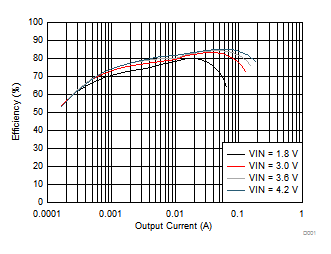
| VIN = 1.8 V, 3.0 V, 3.6 V, 4.2 V, VOUT = 12 V | ||
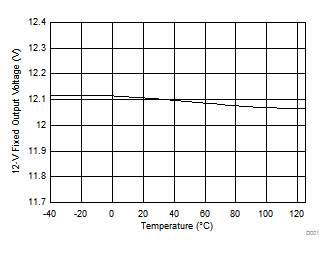
| VIN = 3.6 V, VOUT = 12 V, FB pin connected to VIN pin | ||
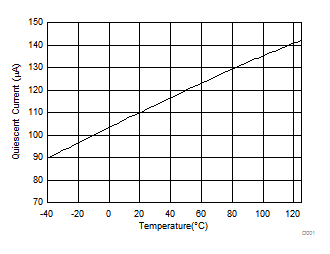
| VIN = 3.6 V, VOUT = 12 V, No switching | ||
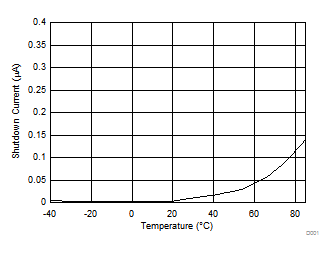
| VIN = 3.6 V | ||
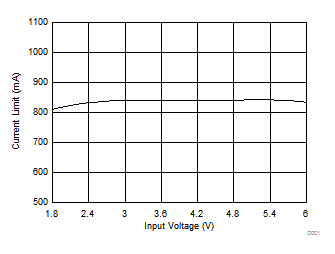
| VIN = 1.8 V ~ 6 V, VOUT = 12 V | ||
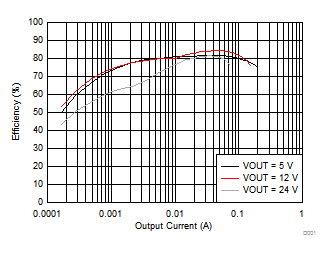
| VIN = 3.6 V, VOUT = 5 V, 12 V, 24 V | ||
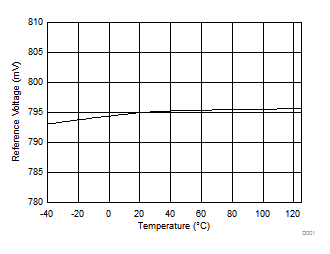
| VIN = 3.6 V, VOUT = 12 V | ||
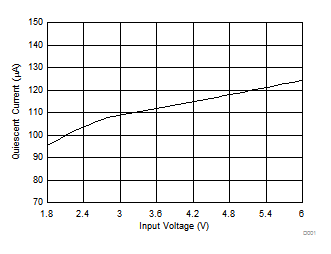
| VIN = 1.8 V ~ 6 V, VOUT = 12 V, No switching | ||
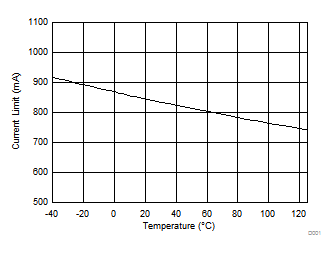
| VIN = 3.6 V, VOUT = 12 V | ||